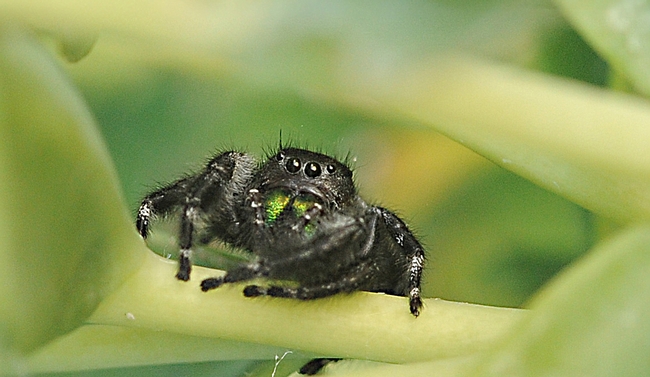
Last summer we spotted what appeared to be the red-backed jumping spider, Phidippus johnsoni (famiiy Salticidae), stalking native bees and honey bees in our yard.
Its iridescent green chelicerae, which characterizes many species in the genus, literally glowed.
It wasn't a good hunter. It missed its prey time after time.
So, it should be interesting when Damian Elias, assistant professor, Department of Environmental Science, Policy and Management, UC Berkeley, comes to UC Davis on Wednesday, Feb. 8 to speak on "Multimodal Communication in Jumping Spiders" from 12:10 to 1 p.m., Wednesday, Feb. 8 in 122 Briggs Hall.
"Animals use a variety of senses to navigate the world," Elias says. "While humans are adept at sensing the world through visual, auditory, and olfactory (smell) information, some animals use senses that are imperceptible to human observers. The vast majority of life on the planet uses vibrations transmitted through solid objects (substrate-borne vibration) to communicate and up until recently, this crucial aspect of animal biology was completely unknown."
The jumping spider he is currently focusing on is Phidippus clarus.
Elias, who received his doctorate in neurobiology and behavior from Cornell in 2005, says he uses behavioral ecology techniques to study different aspects of communication. In particular, he is interested in questions regarding sexual selection, mating system evolution, signal design and responses to population, ecological, and environmental variation.
If you look on YouTube, you'll see an excellent macro video of the same jumping spider, Phidippus clarus, that Damian Elias studies. It's the work of Oklahoma artist Thomas Shahan (who also teaches macro photography in the popular BugShot workshop).
And, if you think that's amazing, check out the even more spectacular images of jumping spider photos on Shahan's website.
Attached Images:

A jumping spider, probably Phidippus johnsoni, eyes the photographer. (Photo by Kathy Keatley Garvey)